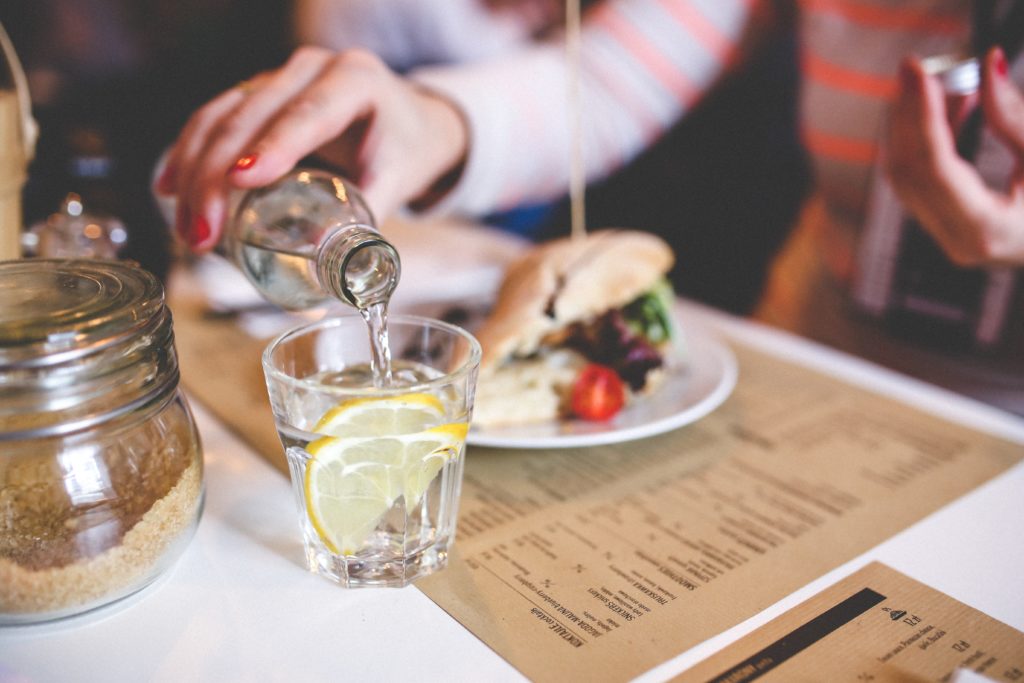Whether you’re eating out on a Friday night or you don’t feel like cooking on a Tuesday evening, dining out is a part of life. Unfortunately, it can also lead to weight gain and conflict with fitness goals, especially when we aren’t in control of what goes into the foods that are prepared for us. There’s no shame in treating yourself once in a while and cooking your own meals majority of the time. In fact, practicing realistic habits is a healthier way of life because you’re still enjoying the foods you love in moderation, but not letting them counteract your fitness goals.
Moderation becomes difficult to achieve when cheat meals turn into cheat days because so many of us think, “well I already ate a bite of that so might as well eat the whole thing.” Although sometimes it’s perfectly fine to order the huge plate of pasta, there’s a healthier way to enjoy life and avoid the guilt that comes along with eating out. Here are some guidelines to follow for your next trip to a restaurant.
Read More: 13 Common Weight Loss Mistakes
Here’s How to Eat Healthy at Restaurants
DRINK WATER OR UNSWEETENED ICED TEA
This sounds like a no-brainer, but water actually helps keep you fuller longer and can prevent overeating. What you want to drink is the first question your server will ask you, so ditch the soda (yes diet soda too) and order a water with lemon or an unsweetened iced tea with lemon. Both are guilt-free and zero-calorie options.
IF YOU’RE ORDERING ALCOHOL
Now it’s no secret that alcohol is probably your worst enemy if you’re trying to lose weight or are focused on fitness, but we’re human and living a healthy lifestyle is about moderation, not restriction. An effective rule of thumb to follow is to avoid any caramel-colored liquors like whiskey, blended mixed drinks and heavy beers. These are packed with tons of sugar, and one drink alone can contain up to 300 calories. So, if it’s a Friday night and you order a few of these, you can imagine that’s not a very pretty math equation. Try to order just one drink and stick to a glass of red wine that has about 150 calories or a vodka soda with about 70 calories.
LOOK FOR THE “LIGHTER” SECTION
You initially might think that this section on a menu sucks the fun and flavor out of your meal, but these dishes are typically just as delicious and are half the calories of what you normally would order. They also help with practicing portion control. How many times have you gone to an Italian restaurant and can’t finish the whole plate of pasta? That’s because restaurants over-compensate portion sizes and your body actually does not need those extra calories. Order off the lighter menu if the restaurant offers it, get a friendlier portion and you’ll most likely be just as satisfied, if not more.
START WITH A SALAD OR SOUP
Get in the habit of “spoiling your appetite” by ordering broth-based soup or a salad with non-creamy dressing on the side before diving into the actual entrée. One of the biggest culprits for weight gain is portion control. It’s not necessarily that you ordered the fettucine alfredo, it’s that you ate too much of it in one sitting and your body can’t digest it properly, so it just gets stored as fat. Plus, we tend to eat whatever is put in front of us and are taught to eat until our plates are clean.
These are dangerous things when dining out considering an average plate of food at a restaurant adds up to about 1500 calories. By starting with soup or a salad before the entrée comes, you’re more likely to eat less of the entrée, but feel just as satisfied.
Avoid making the common mistake of ordering salads with dressings like ranch and blue cheese and avoid cream-based soups. Just because you’re eating a salad or a small bowl of soup does not make it healthier. Most of the cream-based options are packed with fat and equate to a full meal’s worth of calories. By making easy swaps, food still tastes good and your waistline will thank you for it.
LOOK FOR KEYWORDS AND CALORIE COUNTS ON MENUS
This applies to those pesky hidden ingredients in fine print that usually double the calories and fat of an entrée. For example, if you’re looking at the salad section of a menu, most people make the mistake of ordering something because it seems healthy, when a lot of the time, many big salads are loaded with cheese, fried chicken and bacon bits and are topped with creamy dressings that make it even worse for you–so when you think you’re ordering something innocent, it’s actually the same number of calories as a cheeseburger, if not more.
The way to avoid this is to scan the menu descriptions for words like “fried” or “cream.” Also look for good words like “grilled” and “steamed.” If you’re eyeing something that is fried or contains a lot of cheese, simply request your chicken to be grilled instead of fried and ask for no cheese. Restaurants are meant to make these accommodations for people, and no, you aren’t bothering your server or being high maintenance because you requested your food a certain way. You’re paying for it, so you might as well enjoy yourself without the guilt.
Most restaurants nowadays are required to include calorie counts in their menus. Although the goal is not to become obsessed with numbers, the calorie counts are usually a good reference to use when deciding what you’re going to order, but avoid relying on these numbers, as some of them are not as accurate as you might think. Rely on yourself to make the executive decision by being smart about the actual ingredients in the food.
ORDER A HALF PORTION OR SHARE WITH SOMEONE
When you’re starving at a restaurant, your eyes tend to be bigger than your stomach and you think you’re hungrier than you actually are. Plus, good-smelling food that is bursting with flavor doesn’t always help with accurate hunger cues. No matter what dish you’re ordering, try sharing with someone or ordering a half portion.
This way if it’s something that is higher in calories and fat, you’re literally cutting those numbers in half, but you’re still allowing yourself to enjoy the dish, and you’ll most likely still feel full and but not over-stuff yourself. The bill will also look a lot nicer to you because you’ll only be paying for one entrée instead of two. It’s a win-win.
EAT SLOWLY AND FOLLOW THE 5-SECOND RULE
We know that when your dish arrives to your table you’re probably ready to scarf it down. Sit back, take a bite and really be in the moment. By eating slower and actually focusing on the eating aspect, you’re allowing your body to respond to what’s being put in it, giving your brain time to decide when you’re full.
Five seconds is about the amount of time you want to take between each bite. This definitely will feel weird, controlling and unnatural at first, but if you practice it a few times when you go out, eventually, you will naturally adapt to something similar, and will see results from all of your time at the gym because you’re burning more calories than you’re taking in.
MINIMIZE ON DESSERT
Dessert at restaurants is usually best to avoid all together if you’re trying to watch what you eat, but if you’re that person who has a major sweet tooth, take a couple bites of chocolate cake and then be done. When it comes to anything that we crave, especially sweets, our brains don’t need the whole brownie to be satisfied–just a bite or two. Or instead of indulging in the ice cream and cake, order a coffee with a little cream.
FOR TYPES OF CUISINES
Some restaurants don’t have a “lighter section” on their menus. If this is the case, here are some healthier examples of what you could order:
– AMERICAN FOOD
Order a burger with no bun, load up the burger with vegetables, instead of French fries, order a side salad or fruit, and instead of mayonnaise, use mustard.
– ITALIAN FOOD
Order pastas with tomato-based sauces. For example, spaghetti with meatballs isn’t necessarily “healthy,” but it’s a better choice than fettucine alfredo. For pizza, order a side salad to start and then order thin crust pizza with veggies. You’ll still satisfy your pizza craving, but the calories will be a lot kinder to you.
– MEXICAN FOOD
Mexican food tends to be a little more difficult considering everything is mostly deep fried. Luckily, there are still ways around the system. If you’re absolutely craving enchiladas, cut the calories in half by sharing with someone. For an even healthier option that is also filling, order a “taco” salad with chicken, lots of lettuce and guacamole. Ditch the cheese, sour cream and tortilla chips, but load it up with salsa.
– ASIAN FOOD
Since Chinese food is mostly all deep fried and packed with salt and sugar, order a small soup to curb your appetite and try ordering your entrée steamed. If you’re at a sushi restaurant, cut back on the rice by ordering low-carb cucumber sushi. The cucumber replaces the rice, but you still get the sushi taste. Although plain steamed rice isn’t necessarily bad for you, try ordering brown rice instead with more nutrients.
Read More: How to Eat Healthy on a Budget





